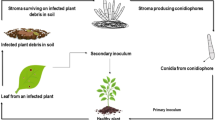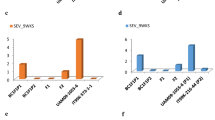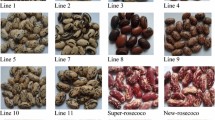Abstract
The fungal disease cercospora leaf spot CLS (Cercospora zonata) has affected major faba bean (Vicia faba) production regions in southern Australian in the last several years. This study offers the first report of sources of resistance to CLS in faba bean and describes techniques to evaluate resistance to C. zonata in faba bean genotypes within a controlled environment. The method was rapid (43 days), repeatable (R 2 > 0.74) and demonstrated positive correlations (R 2 > 0.45–0.80) to data collected from field disease nurseries under naturally established CLS epiphytotics. All faba bean cultivars currently adopted by the Australian industry were found to be susceptible to CLS and defoliation was found to be an important component of disease expression. Genetic analysis of segregation patterns in F 2 derived F 3 families of 1322/2*Farah (resistant*susceptible) showed the mode of inheritance of resistance to C. zonata was monogenic dominant. F 3 families were shown to segregate in the ratio of 1:2:1 for homozygous resistant: heterozygous: homozygous susceptible (χ 22 = 2.78; P > 0.05) and individual plants within heterozygous F 3 families segregated in the ratio of 3:1 for resistant: susceptible responses (χ 21 = 2.93; P > 0.05). Monogenic dominant inheritance also explained the change in frequency of resistant and susceptible plants within a population of cv. Cairo following one generation of self-pollination (χ2 = 0.88, 0.3 < P < 0.5). The sources of resistance identified in this study are being used to transfer CLS resistance to adapted faba bean genotypes for future cultivar releases to the southern Australian industry.




Similar content being viewed by others
References
Baker KF (1957) The UC system for producing healthy container-grown plants. University of California Press, Berkeley
Baker WA, Weaver DB, Qui J, Pace PF (1999) Genetic analysis of frogeye leaf spot resistance in PI54610 and Peking soybean. Crop Sci 39:1021–1025
Barbetti MJ (1985) Infection studies with Cercospora zebrina on pasture legumes in Western Australia. Aust J Exp Agric 25:850–855
Barbetti MJ (1991) Response of subterranean clover varieties to cercospora disease under a controlled environment and in the field. Aust J Exp Agric 31:333–336
Barbetti MJ, Nichols PGH (1994) Field resistance in Trifolium subterraneum to Uromyces trifolii-repentis and Cercospora zebrina. Aust J Exp Agric 34:1131–1136
Barbetti MJ, Nichols PGH (2005) Field performance of subterranean clover germplasm in relation to severity of Cercospora disease. Australas Plant Pathol 34:197–201
Booker HM, Umaharan P (2008) Quantitative resistance to Cercospora leaf spot disease cause by Pseudocercospora cruenta in cowpea. Euphytica 162:167–177
Chupp C (1954) A monograph of the fungus genus Cercospora. Cornell University, New York
Coates ST, White DG (1998) Inheritance of resistance to gray leaf spot in crosses involving selected resistant inbred lines of corn. Phytopathology 88:972–982
Johnson CS, Beute MK, Ricker MD (1986) Relationship between components of resistance and disease progress of early leaf spot on Virginia-type peanut. Phytopathology 76:495–499
Kimber RBE, Paull J, Davidson JA (2004) Screening methodologies to identify resistance to Ascochyta leaf blight (Ascochyta fabae) in faba bean germplasm. In: Proceedings of the 5th European conference on grain legumes, 7–11 June, Dijon France, p 326
Lang L, Yu Z, Zheng Z, Xu M, Ying H (1993) Faba bean in China: state-of-the-art review. ICARDA, Aleppo
Latterell FM, Rossi AE (1983) Gray leaf spot of corn: a disease on the move. Plant Dis 67:842–847
Mishra SP, Asthana AN, Yadav L (1988) Inheritance of Cercospora leaf spot resistance in mung bean, Vigna radiata (L.) Wilczek. Plant Breed 100:228–229
Paull JG, Kimber RBE (2006) Breeding faba bean for resistance to chocolate spot. In: Avila CM et al (eds) Proceedings of the international workshop on faba bean breeding and agronomy, 25–27 Oct. Cordoba, Spain, pp 117–120
Ricker MD, Beute MK, Campbell CL (1985) Components of resistance in peanut to Cercospora arachidicola. Plant Dis 69:1059–1064
Saghai Maroof MA, Yue YG, Xiang ZX, Stromberg EL, Rufener GK (1996) Identification of quantitative trait loci controlling resistance to gray leaf spot disease in maize. Theor Appl Genet 93:539–546
Shane WW, Teng PA (1992) Impact of Cercospora leaf spot on root weight, sugar yield, and purity of Beta vulgaris. Plant Dis 76:812–820
Smith GA, Campbell LG (1996) Association between resistance to Cercospora and yield in commercial sugarbeet hybrids. Plant Breed 115:28–32
Smith DH, Littrell RH (1980) Management of peanut foliar diseases with fungicides. Plant Dis 64:356–361
Tessman DJ, Charudattan R, Preston JF (2008) Variability in aggressiveness, cultural characteristics, cercosporin production and fatty acid profile of Cercospora piaropi, a biological agent of water hyacinth. Plant Pathol 57:957–966
Tivoli B, Baranger A, Avila CM, Banniza S, Barbetti M, Chen W, Davidson J, Lindeck K, Kharrat M, Rubiales D, Sadiki M, Sillero JC, Sweetingham M, Muehlbauer FJ (2006) Screening techniques and sources of resistance to foliar diseases caused by major necrotrophic fungi in grain legumes. Euphytica 147:223–253
Ward JM, Stromberg EL, Nowell DC, Nutter FW (1999) Grey leaf spot. A disease of global importance in maize production. Plant Dis 83:884–895
Williams MAJ (1987) CMI descriptions of pathogenic fungi and bacteria. CAB International. Martinus Nijhoff/Dr W. Junk, Dordrecht, pp 185–186
Windels CE, Lamey HA, Hilde D, Widner J, Knudsen T (1998) A Cercospora leaf spot model for sugar beet. Plant Dis 82:716–726
Wolf PFJ, Verreet JA (2002) Development and implementation of an integrated pest management system in Germany for the control of fungal leaf diseases in sugar beet: the IPM sugar beet model. Plant Dis 86:336–344
Woodward RC (1932) Cercospora fabae Fautrey, on field beans. Trans Br Mycol Soc 17:195–202
Yu TF (1947) Cercospora leaf spot of broad bean in China. Phytopathology 37:174–179
Acknowledgments
The authors sincerely thank: Kevin James, Ian Roberts and Michelle Russ for invaluable technical support; Jenny Davidson and Assoc. Prof. Eileen Scott for scientific input, and the Grains Research and Development Corporation (GRDC) for funding this study. This study was in part to fulfil requirements of a Doctorate of Philosophy (PhD) for Rohan Kimber.
Author information
Authors and Affiliations
Corresponding author
Rights and permissions
About this article
Cite this article
Kimber, R.B.E., Paull, J.G. Identification and genetics of resistance to cercospora leaf spot (Cercospora zonata) in faba bean (Vicia faba). Euphytica 177, 419–429 (2011). https://doi.org/10.1007/s10681-010-0288-7
Received:
Accepted:
Published:
Issue Date:
DOI: https://doi.org/10.1007/s10681-010-0288-7




